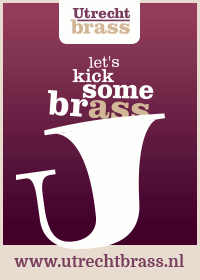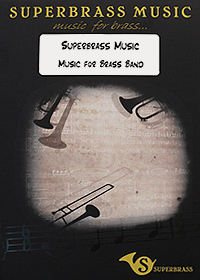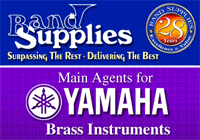David Childs at the RAH - BBC Proms
3-Sep-2004BBC Proms
National Orchestra of Wales
David Childs,Euphonium
Royal Albert Hall,
2nd September 2004
One would be rather hard-pressed to find a more eclectic mix for a concert than the items chosen here: a recent work by a contemporary composer with a foot in the world of television theme tunes; extracts from a 1940 musical; a new concerto by one of the leading UK composers of the older generation; and a Symphony written at the end of the Second World War that surprised its audience at the time, who were expecting something of an epic to follow Beethoven's example.
It says a lot for the versatility of the BBC National Orchestra of Wales, under their conductor Grant Llewellyn, that they were able to hold such a mixture together and make it such a satisfying concert-going experience.
Joby Talbot's "Sneaker Wave" that opened the programme owes its title not to someone holding a plimsoll over his head, but rather to the phenomenon in nature where a wave that is a little bigger than normal grows stronger and stronger, engulfing others in the process. The piece uses a 15-note pulse and a 14-note phrase, so there is constant change as the music flows, but this was no dry, minimalist exercise.
Starting with the woodwind and moving throughout the orchestra, various notes were highlighted and picked out, using the full range of colours available, including a wide array of percussion. Piano and celesta are incorporated in the orchestra, with the harp also prominent at times. The recently restored Royal Albert Hall organ joined in at the powerful climax, before the wave abated and quickly dispersed. After a few minutes, with the conductor looking around the hall in vain, the composer, who amongst other credits is responsible for the theme music for "Tomorrow's World", "Robbie's Reindeer" and "The League of Gentlemen", appeared down the steps to acknowledge the audience's applause.
"Lady in the Dark" was a collaboration between Kurt Weill, recently arrived in the States having fled Hitler's Germany, Ira Gershwin and the playwright Moss Hart. For the selection chosen the orchestra was much reduced - only four brass, five woodwind and a much pared down string section, with the drum kit position in the centre of the ensemble. From the opening notes of the Overture the versatility of the brass was apparent, led by Philippe Schartz, no doubt familiar to many via his solo cds and guest appearances with the BAYV Band, and with Katy Pryce, 1996 brass winner in the BBC Young Musician competition, on trombone. With suitably sleazy trumpets, they played with a combination of brashness at times, followed by delicacy when called upon to fade into the background. The vocalist was Ruthie Henshall, possibly best remembered from her role in "Les Miserables" and the subsequent 10th Anniversary recording, also made at the Royal Albert Hall.
Unfortunately the amplification in the hall, at least to those in the Arena, was not ideal, and this in songs where the words are vital to convey the at times biting humour. Things did improve over the four songs, and the words were printed in the programme, but it is a pity that, despite all Miss Henshall's efforts and enthusiasm, there did not seem to be the audience response that there would have been had the balance been better. The contribution of the orchestra was first class, especially the brass, with a particularly fine rendition of "My Ship" from Katy Pryce in the overture, and the selection of pieces went down well with the listeners.
When David Childs approached Alun Hoddinott to write a concerto for him, he was already familiar with him as a player due to his involvement with the BBC Young Musician in 2000, when he won the brass section of the competition. Perhaps the leading Welsh composer of his generation, Alun Hoddinott is no stranger to brass, with works for brass quintet and solo pieces featuring horn, trumpet and trombone to his name.
With the subtitle "The Sunne Rising - The King will Ride", taken from a poem by John Donne, the ensuing concerto is made up of six sections, played continuously, and exploits two facets of the euphonium in particular - its liking for smooth warm melodies and its fluency in fast flowing passages. Varying from the sombre lyricism of the opening, through the energetic sections depicting the king riding, to the challenging cadenza, the work makes an ideal showcase for such a player as David Childs. From the outset, his clear tone made a striking impression, as his initial statement of the theme over a gentle wash of orchestral sound was answered by the orchestral horns.
Particularly impressive was the uniformity of sound across the full range of the instrument, so that both pedal notes and high passages truly serve the musical intention rather than becoming mere effects. Throughout, the at times angular phrases of each note was centred and the attack clear, whilst the more spectacular glissandi featured towards the end of the piece seemed totally in context. Towards the end of the Andante section there did seem to be a slight tuning discrepancy between the soloist and the accompanying trombones, but it was soon resolved. The orchestration of the concerto - for an orchestra of classical proportions (double woodwind, no tuba but wide array of percussion) - was quite luminous, enabling the soloist to be heard
at all times, and with some quite magical moments where the harp ad percussion added their touch over the string chords.
The cadenza itself was preceded by a purely orchestral episode, for which the soloist was probably grateful as he had been playing continuously up to that point. Heralded by woodwind features, the cadenza itself is unaccompanied, and represents quite a tour de force, the performance notable for some very clear articulation, before the concluding Vivo section, where the soloist took the chance to soar over the orchestra.
There was a poignant moment when, following the conclusion of the piece, the 75 year old composer joined David on the stage to receive the audience's acclaim, led by a number of brass aficionados in the gathering but shared by many more whose ears had been opened to new musical possibilities. The soloist left the stage, bouquet deposited in the bell of the euphonium, and it is to be hoped that it will not be too long before he is invited back, possibly to showcase another new work from one of our leading composers, or even as soloist in an all-brass concert.
The final item in the concert was the 9th Symphony by Shostakovich. Since Beethoven, particular significance had been attached to 9th Symphonies and, coming as it did at the end of the War, expectations were high when the new work was premiered in 1945. Instead of the anticipated epic, the resulting
work was much lighter in tone, though not without it sombre moments. Scored for a fairly small orchestra, it owes much to Haydn in its skittishness, which the orchestra conveyed very effectively. The strings in particular seemed to relish in the opportunities afforded to them, whilst the characteristic spikiness of the woodwind writing played its part.
The heavy brass were absent from the second movement, the woodwind soloists taking centre stage, before the Presto brought in an element of the Russian circus - echoes of Peter Graham's "Call of the Cossacks" sprang to mind, particularly with the brash trumpet solo. With little warning a beautifully played bassoon solo ushered in a plaintive Largo, quite grim, with octave phrases in the lower brass and the bassoon reaching up to its the top register, before descending again to introduce a livelier folk-like theme that orchestra gradually picked up. The music of Shostakovich is full of humour, albeit tinged with acidic moments, and the orchestra conveyed that effectively as they drew the evening to a close.
The audience in the hall, which appeared to be about half-full, had shared in some fine music making, joined by those listening over the airwaves, and left the hall in a buoyant mood.
Peter Bale
Copyright 4BR









